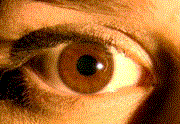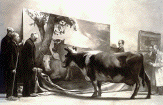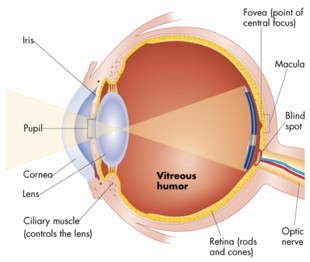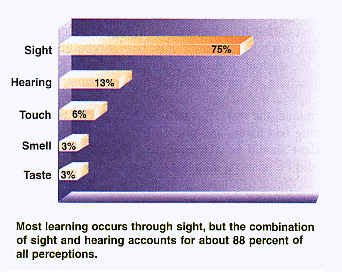
 seeing or sight
- To perceive with the
eye, to visually apprehend. Or, to visualize;
to create a mental image
of. Also, to detect by any means similar to the use of the eye,
as in the use of photography.
seeing or sight
- To perceive with the
eye, to visually apprehend. Or, to visualize;
to create a mental image
of. Also, to detect by any means similar to the use of the eye,
as in the use of photography.
Physically, sight requires that
light is cast  upon the pupil
of one or both of the eyes, pass through the lens,
through the aqueous and
vitreous humors, onto the
retina. From the photoreceptors there — millions
of light sensitive nerve
endings called rods and
cones — nerve impulses
must then be transmitted through the optic nerve to the brain.
In the brain, these nerve messages are analyzed for their arrangement / pattern, and its meaning.
(See elements of art and
principles of design.)
upon the pupil
of one or both of the eyes, pass through the lens,
through the aqueous and
vitreous humors, onto the
retina. From the photoreceptors there — millions
of light sensitive nerve
endings called rods and
cones — nerve impulses
must then be transmitted through the optic nerve to the brain.
In the brain, these nerve messages are analyzed for their arrangement / pattern, and its meaning.
(See elements of art and
principles of design.)
"Seeing" and "sight"
are often used to emphasize the quality
which differentiates seeing from mere looking, comprehending or
understanding a sight's meaning
rather than merely apprehending its pattern of light.
Other synonyms: view, gaze,
behold, note, notice, espy, descry, observe, contemplate, examine,
survey, and discern.

- "First I saw the mountains in the
painting; then I saw the painting in the mountains."
Chinese Proverb.
- "The artist alone sees spirits. But
after he has told of their appearing to him, everybody sees them."
Johann Wolfgang Von Goethe (1749-1832), German author.
- "Close your bodily eye, that you
may see your picture first with the eye of the spirit. Then bring
to light what you have seen in the darkness, that its effect
may work back, from without to within."
Caspar David Friedrich (1774-1840), German Romantic painter. Quoted by Carius,
Friedrich der Landschaftmaler, 1841.
- "Never lose an opportunity of seeing
anything that is beautiful."
Ralph Waldo Emerson (1803-1882), American writer.
- "The question is not what you look
at, but what you see."
Henry David Thoreau (1817-1862), American writer.
- "You do not see with the lens of
the eye. You see through that, and by means of that, but you
see with the soul of the eye."
John Ruskin (1819-1900), English art critic.
- "We must . . . give the image of
what we actually see."
Paul Cézanne (1839-1906), French Post-Impressionist
painter.
- "The day is coming when a single
carrot, freshly observed, will set off a revolution."
Paul Cézanne.
- "Yet in spite of the total disregard
of the dictionary of manners, he shows a politeness toward us
which no other man here would have shown . . . Cézanne
is one of the most liberal artists I have ever seen. He prefaces
every remark with Pour moi it is so and so, but he grants
that everyone may be as honest and as true to nature from their
convictions; he doesn't believe that everyone should see alike."
Mary Cassatt (1845-1926), American Impressionist painter. In a letter to
Mrs. Stillman, 1894.
- "I shut my eyes in order to see."
Paul Gauguin (1848-1903), French Post-Impressionist
artist.
- "The painter should not paint what
he sees, but what will be seen."
Paul Valéry (1871-1945), French poet, essayist.
- "Art does not reproduce the visible;
rather, it makes visible."
Paul Klee (1879-1940), Swiss artist, teacher
at the Bauhaus.
- "Nobody sees a flower, really — it
is so small — we haven't time, and to see takes time, like to
have a friend takes time."
Georgia O'Keeffe (1887-1986), modernist American painter.
- "It is only with the heart that one
can see rightly; what is essential is invisible to the eye."
Antoine de Saint-Exupéry (1900-1944), French writer and
aviator.
- "I make a head to see how to see,
to know how to see, not to make a work of art."
Alberto Giacometti (1901-1966), Swiss sculptor
and painter. Peter Selz, Alberto Giacometti, 1965.
- "Learning to draw is really a matter
of learning to see — to see correctly — and that means a good
deal more than merely looking with the eye."
Kimon Nicolaides (1892-1938) American painter, muralist, gallery owner, and teacher. His book, The Natural Way to Draw, was published in 1941, three years after his death.
- "What you see is what you see."
Frank Stella (1936-), American painter, in an interview,
1966.
- "Light in the absence of eyes illuminates
nothing. Visible forms are not inherant in the world, but are
granted by the act of seeing. Events contain no meaning in themselves
only the meaning that the mind imposes on them."
Dialogue written for Trevor Goodchild, a character in Æon
Flux, a series of animated films created by Peter Chung,
Colossal Pictures, and MTV, 2001. Quoted here thanks to Greg
Bien.
- A joke:
A painter in the prime of her career started losing her eyesight.
Fearful that she might lose her life as a painter, she went to
see the best eye surgeon in the world.  After several weeks of delicate surgery and therapy,
her eyesight was restored.
After several weeks of delicate surgery and therapy,
her eyesight was restored.
The painter was so grateful that she decided to show her gratitude
by repainting the walls of her doctor's office. Part of her work
included painting an image of a gigantic eye on one wall. When
she had completed her work, she held an opening to unveil her
latest work of art: the doctor's office.
During the opening, a reporter remarked on the eye on the wall,
and asking the doctor, "What was your first reaction upon
seeing your newly painted office, especially that large eye on
the wall?" To this, the eye doctor responded, "I said
to myself, 'Thank heavens, I'm not a gynecologist.'"
Works that are especially
about seeing:
Greek, Attic, Black-Figure Eye Cup with Ships, Archaic,
c. 530 BCE,
terra cotta, Michael C. Carlos
Museum, Emery U, Atlanta, GA. This cup appears to act as a mask when the
cup is raised to drink — the eyes staring out, the handles resembling
ears, and the foot of the vase appearing as a mouth. The
eyes serve an apotropaic
function, driving away
evil. See anthropomorphism, black-figure, ex
voto, Greek
art, talisman, vessel, and votive.

 Maurits
Cornelis Escher (Dutch, 1898-1972), Eye, 1946, mezzotint,
7th and final stage.
Maurits
Cornelis Escher (Dutch, 1898-1972), Eye, 1946, mezzotint,
7th and final stage.

 Mark Tansey (American, 1949-), The Innocent Eye Test, 1981, oil
on canvas, Metropolitan
Museum of Art, NY. Mark Tansey is known particularly for his
Mark Tansey (American, 1949-), The Innocent Eye Test, 1981, oil
on canvas, Metropolitan
Museum of Art, NY. Mark Tansey is known particularly for his
 monochromatic
paintings which are often humorous mock-historical scenes that refer to art historical subjects.
This picture depicts a group of men who are showing an actual
cow
monochromatic
paintings which are often humorous mock-historical scenes that refer to art historical subjects.
This picture depicts a group of men who are showing an actual
cow  a painting of
cows by Paulus Potter (Dutch, 1625-1654), The Young Bull, 1647. See pastoral.
a painting of
cows by Paulus Potter (Dutch, 1625-1654), The Young Bull, 1647. See pastoral.
Two cross-sections of the human eye:





Protect your
eyes, and those of everyone else your activities might affect.
Wear protective eye covering whenever the eyes are exposed to
hazards.

Also see afterimage,
art, artist, binocular
vision, blind spot,
colorblind, cross-section,
gestalt, iris,
mirror, night
blindness or nyctalopia,
ophthalmology, Op
Art, optics, optical
illusion, optical mixing,
perception, peripheral
vision, refraction,
science and art, senses, stereoscopic
vision, subliminal message
or subliminal advertising,
ultraviolet, visuality, visual
qualities, voyeurism,
and wide-angle.


https://inform.quest/_art


 upon the pupil
of one or both of the eyes, pass through the lens,
through the aqueous and
vitreous humors, onto the
retina. From the photoreceptors there — millions
of light sensitive nerve
endings called rods and
cones — nerve impulses
must then be transmitted through the optic nerve to the brain.
In the brain, these nerve messages are analyzed for their arrangement / pattern, and its meaning.
(See elements of art and
principles of design.)
upon the pupil
of one or both of the eyes, pass through the lens,
through the aqueous and
vitreous humors, onto the
retina. From the photoreceptors there — millions
of light sensitive nerve
endings called rods and
cones — nerve impulses
must then be transmitted through the optic nerve to the brain.
In the brain, these nerve messages are analyzed for their arrangement / pattern, and its meaning.
(See elements of art and
principles of design.) After several weeks of delicate surgery and therapy,
her eyesight was restored.
After several weeks of delicate surgery and therapy,
her eyesight was restored.
Maurits
Cornelis Escher (Dutch, 1898-1972), Eye, 1946, mezzotint,
7th and final stage.

Mark Tansey (American, 1949-), The Innocent Eye Test, 1981, oil
on canvas, Metropolitan
Museum of Art, NY. Mark Tansey is known particularly for his
 monochromatic
paintings which are often humorous mock-historical scenes that refer to art historical subjects.
This picture depicts a group of men who are showing an actual
cow
monochromatic
paintings which are often humorous mock-historical scenes that refer to art historical subjects.
This picture depicts a group of men who are showing an actual
cow a painting of
cows by Paulus Potter (Dutch, 1625-1654), The Young Bull, 1647. See pastoral.

![]()

